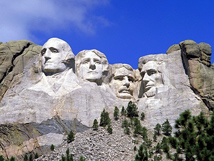|
Welcome
to South Dakota

Tourism
Links for South Dakota
Growing up as a 4th generation South Dakotan, I want to express
how captivating South Dakota is. From the ruggedness
of our many state parks to the Black Hills National Forest,
to the grandeur of Mt. Rushmore, to some of the best hungting
and fishing in the world, to the golden wheat fields, you'll
agree that there is no better place to vacation than in South
Dakota.
After agriculture, tourism is South Dakota's largest industry.
Each year South Dakota entertains thousands of visitors, won't
you be one of them? I invite you to come and discover
South Dakota!
Click
here to learn about the geography and climate of South
Dakota.
Read about South Dakota's history.
State
Information

Request South Dakota tourism information.
South
Dakota State Parks
Ellsworth
Air Force Base
National
Parks and Forests
Black
Hills
Badlands
Lewis and Clark Bi-Centennial
Mount
Rushmore
National
Wildlife Refuges

Independent
Points of Interest
Crazy
Horse Monument
Booth
Fish Hatchery, Spearfish
Glacier
Lakes and Prairie Tourism Association
Laura
Ingalls Wilder Homestead
Corn
Palace
Reptile
Gardens
Historic
Deadwood
National
Caves
Jewel
Cave
Wind
Cave
Return
to Top
Climate
Average
January temperatures: 10F (-12C) in the northeast to 25F (-4C)
in the southwest.
Average
July temperatures: 69F (21C) in the Black Hills to 75F (24C)
in the southcentral part of the state.
Average
annual precipitation: 80-90% falls as rain, 14 inches in the
northwest to 25 inches in the southeast; 22 inches in the
Black Hills.
Average
annual snowfall: 24-30 inches across most of the state; 60-100
inches in the Black Hills.
Record
low temperature: -58F (-50C) at McIntosh, February 17, 1936
Record high temperature: 120F (49C) at Gann Valley, July 3,
1936
Winter
(late November - early March). While temperatures can be cold,
cold spells usually alternate with milder weather. Snowfall
is prevalent, providing excellent conditions for winter sports.
Spring (late March - mid-June). Mostly sunny days, but this
can be the rainy season. Spring snow showers are a possibility
through early May. Temperatures can range from the 40s (4C)
to the 80s (27C). When the sun's shining, the early spring
flowers are out in full force.
Summer
(mid-June - mid-September). Warm (sometimes hot) days and
cool nights are the norm from mid-June through mid-September.
Fall
(mid-September - November). Beautiful days with comfortable
warm weather through September and crisp cool weather into
November make fall an excellent time to explore South Dakota.
Geography
South
Dakota ranks 16th in size among the 50 states.
The
state is 77,123 square miles: 380 miles across from east to
west and 245 miles from north to south.
South
Dakota is bounded on the north by North Dakota; on the east
by Minnesota, Iowa, and the Big Sioux and Red Rivers; on the
south by Nebraska and the Missouri River; on the west by Wyoming
and Montana
Geographical Features:
Black
Hills, Badlands, Missouri River reservoirs, Glacial Lakes
Highest
Point: Harney Peak; 7,242 feet (2,173 m)
Lowest Point: Big Stone Lake; 962 feet (289 m)
Major
Rivers: Missouri River, James River, Cheyenne River
(Missouri River divides the state in half, running north to
south)
Return
to Top
|

